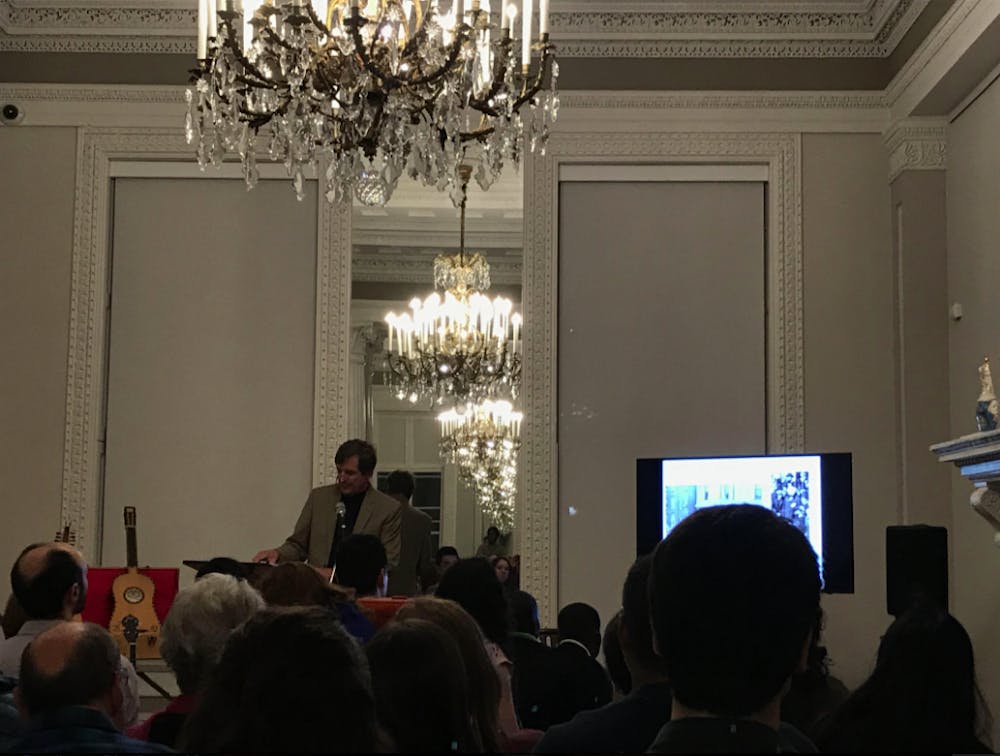Climbing down the magnificent staircase embellished with an intricate pattern, I set foot in the masterpiece situated in the heart of Mount Vernon. My eyes spiraled upward to admire the crystal-like glowing emerald skylight. Being part of the Walters Art Museum, 1 West Mount Vernon Place is a work of art on its own.
During my visit to the museum on Oct. 25, I got to experience an additional work of art in the form of a concert and lecture by Professor David Hildebrand, director of the Colonial Music Institute and an adjunct instructor at Peabody. He educated and amused the audiences with his presentation of a student concert featuring period music from the 19th and 20th centuries.
Hildebrand addressed the program as a presentation of a “musical Maryland,” telling the history and music of this mansion in chronological order. The Thomas family built 1 West in the mid- to late-19th century; the Jencks lived here the longest, from the 1890s to 1953; and in the ‘60s Harry Gladding purchased this mansion and revived it.
The masters of the property changed, and the forms of entertainment changed with them. During Hildebrand’s talk he presented several pieces of music that documented the change in people’s taste throughout time, and he brought guitars of different time periods to show the evolution of string music. Among all the songs, one in particular tickled the audiences: “Tobacco’s But An Indian Weed.”
Tobacco had been a controversial subject in Maryland: The lure of profits from tobacco plantations became one of Marylanders’ main sources of income. Therefore mariners gave another name to the Chesapeake — the Tobacco Coast.
Hildebrand beautifully sang, “The pipe that is so foul within, it shows man’s soul is stained with sin; it doth require to be purred with fire; think of this when you smoke tobacco!” While people were amused by the song, I realized that this beautiful mansion also flourished upon the tobacco economy, which dragged me into lamentation on the inhumane slave trade and inequality that capitalism had created.
The music also alluded to gender inequality in the earlier century. While the audience was moved by the melodies played on the harp, Hildebrand revealed that the harp was considered an instrument that was designed for ladies.
Upper-class women were not allowed to leave the household, so they found ways to amuse themselves; the ensuing prolificacy in music production might have been involuntary. Music possesses the power of being the honest storyteller that records the minute details of time, and it unfolds the story without alteration or decay of the facts.
Hildebrand is no doubt a most satisfactory host to walk people through the historical tunes of Baltimore. A specialist in early American music, Hildebrand has presented educational programs and concerts throughout the country for all kinds of audiences and occasions, and his music brightens a lot of television documentaries, such as Rediscovering George Washington, Liberty! — the American Revolution and Anthem — The Story of “The Star-Spangled Banner.”
As a resident of Maryland, Hildebrand has also added publishing a book about early music in the state to his already impressive list of accomplishments. He published Musical Maryland: A History of Song and Performance from the Colonial Period to the Age of Radio in 2017 to demonstrate his research as a musical historicist.
After the presentation I took some time to walk around the mansion and appreciate the works of art displayed. The series of paintings hung in the entrance hall were American and European landscape paintings created during the same period of the birth of 1 West Mount Vernon Place.
Combining reality and the ideal, these paintings served to extol the glory of natural scenery, setting off the impressive manor. The porcelains, statues and library cases exhibited helped satisfy people’s curiosity and expand their knowledge.
Art is an embodiment of history, and music is the most candid form of art — there is no barrier to understanding melodies. I was pleased by my visit to 1 West Mount Vernon Place, and I will definitely return to explore the other parts of the museum containing both the permanent exhibitions and the pop-up events.





